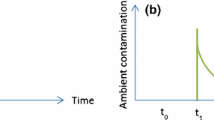Abstract
In this paper, the problem of optimal timing, when to adopt an environmental policy in a strategic framework is considered. Using real options theory and some basic tools of game theory, we show that, under certain assumptions, a country behaving strategically should wait longer before adopting such a policy than if it behaves unstrategically or within a larger entity. Such a postponed decision is sub-optimal as regards to the environment protection.
Similar content being viewed by others
References
A. Baranzini, M. Chesney and J. Morisse, Uncertainty, climate catastrophes and global warming policy, International Academy of the Environment, Publication W85 (http://ecolu-info.unige.ch/~baranzin/WP/AIE-WP85.pdf) (1999).
D. Bentaleb, L'homme une espèce menacée?, Science & Vie n° 964 (1998).
J. Bertoin, Lévy Processes (Cambridge University Press, 1996).
O. Cadot and B. Sinclair-Desgagné, Environmental standards and industrial policy, Journal of Environmental Economics and Management 29 (1995) 228–237.
C. Carraro and D. Siniscalco, Strategies for the international protection of the environment, Journal of Public Economics 52 (1993) 309–328.
G. Chichilnisky and G. Heal, Global environmental risks, Journal of Economic Perspectives 7(4) (1993) pp. 65–86.
W.R. Cline, The economics of global warming, Institute for International Economics (1992).
A.K. Dixit and R.S. Pindyck, Investment under Uncertainty (Princeton University Press, 1993).
D. Fudenberg and J. Tirole, Game Theory (MIT Press, 1991).
C. Gollier, Time horizon and the discount rate, Journal of Economic Theory (forthcoming).
C. Gollier, B. Jullien and N. Treich, Scientific progress and irreversibility: an economic interpretation of the precautionary principle, Journal of Public Economics 75 (2000) 229–253.
C. Gollier and J.C. Rochet, Discounting an uncertain future, Journal of Public Economics (forthcoming).
IMF, www.imf.org.
Information Unit for Conventions, United Nations Environment Programme, Understanding climate change: A beginner's guide to the UN framework Convention and its Kyoto Protocol (www.unep.ch) (1999).
International Energy Agency, An assessment of liability rules for international GHG emissions trading, Information Paper (www.iea.org) (1999).
H. Kempf, Les preuves du réchauffement climatique?, Le Monde (3 November 2000).
H. Kempf and M. Laronche, Faut-il mettre en marché les droits de polluer?, Le Monde Economie (21 March 2000).
M.S. Kimball, Precautionary saving in the small and in the large, Econometrica 58(1) (1990) 53–73.
B. Lambrecht and W. Perraudin, Real options and preemption under incomplete information, Journal of Economic Dynamics and Control (forthcoming).
R. Mc Donald and D. Siegel, The value of waiting to invest, Quaterly Journal of Economics 101(4) (1986) 707–727.
OECD, www.oecd.org.
OECD Information Paper, International emissions trading under the Kyoto Protocol (www.oecd.org) (2000).
OECD Information Paper, International greenhouse gas emission trading: annex 1 expert group on the United Nations framework Convention on climate change (www.oecd.org) (2000).
OECD Information Paper, Lessons from existing trading systems for international greenhouse gas emission trading: annex 1 expert group on the United Nations framework Convention on climate change (www.oecd.org) (2000).
R.S. Pindyck, Irreversibilities and the timing of environmental policy, Working Paper (http://web.mit.edu/rpindyck/www/envtime.pdf) (1999).
L. Rogers and D. Williams, Diffusions, Markov Processes and Martingales, Vol. 2 (Wiley Series in Probability and Mathematical Statistics, 1987).
D. Spulber, Regulation and Markets (MIT Press, 1989).
J. Tirole, The Theory of Industrial Organization (MIT Press, 1990).
L. Trigeorgis, Real Options (MIT Press, 1998).
A. Ulph and D. Ulph, Global warming, irreversibility and learning, The Economic Journal 107 (May 1997) 636–650.
United Nations Organisation, Protocole de Kyoto à la Conventioncadre des Nations Unies sur les changements climatiques, Official Document (www.un.org) (1997).
E.B. Weiss, In Fairness to Future Generations: International Law, Common Patrimony and Intergenerational Equity (The United Nations University and Transnational, Tokyo and Dobbs Ferry, NY, 1989).
M.L. Weitzman, Why the far-distant future should be discounted at its lowest possible rate, Journal of Environmental Economics and Managemen 36 (1998) 201–208.
D. Williams, Diffusions, Markov Processes and Martingales (Wiley Series in Probability and Mathematical Statistics, 1979).
World Bank, www.worldbank.org.
Author information
Authors and Affiliations
Rights and permissions
About this article
Cite this article
Barrieu, P., Chesney, M. Optimal Timing to Adopt an Environmental Policy in a Strategic Framework. Environmental Modeling & Assessment 8, 149–163 (2003). https://doi.org/10.1023/A:1025539106213
Issue Date:
DOI: https://doi.org/10.1023/A:1025539106213




